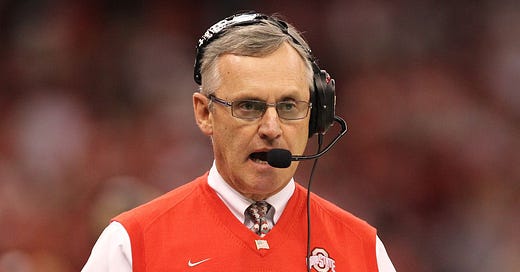In the legendary history of Ohio State football, many names stand out — Woody Hayes, Urban Meyer, Earle Bruce — but perhaps none of them stand out to me quite like Jim Tressel. Tressel was the Buckeyes’ head coach as I was coming of age, and I watched his squad destroy many an opponent on Saturdays. When I think of Ohio State, his is the face that always comes to mind.
Jim Tressel was always going to be a football coach. His father, Lee Tressel, coached at Jim’s high school and also for decades at Jim’s college, Baldwin Wallace. Jim would play under his father in college, to great success. Subsequently, he began his own coaching career, working his way up the coaching positions to being the head coach of Youngstown State, his wife’s alma mater. He would lead the school to multiple Division I-AA titles, making him and his father the first father–son duo to have both won Division I-AA National Titles. He would be named Division I-AA Coach of the Year four times.
In 2001, he was hired by Ohio State. During a preseason basketball game shortly after his hiring, Tressel assured Buckeye faithful:
[Y]ou will be proud of your young people in the classroom, in the community, and most especially in 310 days in Ann Arbor, Michigan, on the football field.1
Tressel made good on his oath, shocking the 11th-ranked Michigan Wolverines, Ohio State’s bitter rival, 26–20 in Ann Arbor. The Buckeyes had not won in Ann Arbor in 14 appearances, and despite the tepid 7–5 record of Tressel’s first year, this victory was an omen of the dominance to come.
Tressel coached for nine years, amassing two 19-game winning streaks, during the 2002–2003 and 2005–2006 seasons. His 81% winning percentage over his nine years of coaching is tied for the second best in school history, surpassed only by Carroll Widdoes, who did not coach more than 18 games total at Ohio State. He would lead Ohio State to its first National Championship in 32 years.
Tressel sported a sweater vest during games, and generally embodied the sort of stern, conservative excellence people have identified as “WASPy.” But his philosophy went well beyond mere aesthetics; it was the very essence of “Tresselball.”
Tressel was foremost of the style of football traditionally associated with the Big Ten: smashmouth, defensive, field position-dependent games that demanded discipline as much as talent. This brand of football has been steadily going out of style, but when it can be seen, it offers a window into what football used to be. When it was said that football trained America’s sons for war, it was just this type of football that was held in mind. It is not flashy; it is determined, fastidious, and unmistakably disciplined. This type of conservative football cannot succeed without a unity born through respect and experience.
Tressel was also heavily involved in the Fellowship of Christian Athletes, and is said to have repeated often a poem2 to keep him grounded amid “this crazy world of athletics”:
The hall of fame is only good as long as time shall be
But keep in mind God’s hall of fame is for eternity.
To have your name inscribed up there is greater more by far
Than all the praise and all the fame of any manmade star.
Tressel’s tenure at Ohio State came to an end when the NCAA, an organization of bureaucratic busybodies, came after him for his players selling memorabilia to a local tattoo parlor. The entirety of his 2010 wins were vacated, and after a protracted back-and-forth, Tressel resigned. It should be noted that the behavior for which Tressel was forced out was not only widely practiced by SEC schools of the time, but that as of a few years ago, it is permitted. When one thinks of the loathsome parts of the managerial HR state we live in, few organizations so perfectly embody its smallminded legalism as the NCAA. Both the schools and the NCAA itself profited enormously off the name and likeness of these players, and yet they never once seemed to find the hypocrisy of their crusade worthy of note.
Regardless of what the NCAA decreed, Jim Tressel is celebrated as a great coach of a great college football program. Especially in light of the present permissibility of the supposed wrongs he committed, he should be remembered fondly. Tressel remains a figure representative of stern American Excellence, and for that he should not be forgotten.
Jim Weber, “Tressel Eyes Finally Bucking the Wolverines,” The Michigan Daily, July 23, 2001.
David Yonke, “Aiming for God’s Hall of Fame,” The Toledo Blade, May 11, 2002.




“O-H!” Pleasant little read this morning, especially on a great coach. One of the greatest national championship games is Tressel’s Buckeyes win over Miami.
Tho he destroyed many teams, he also has us tearing up the furniture with nerves when a 20-3 half time lead turned into a 20-17 win based on exemplary punting. I believe he was a pioneer of analytics, of the brand that learned to shorten the game to eliminate chance/luck. The rules have changed enough that you can't bank on a defense to hold in the last 3 minutes. But he was a great coach and the teams had stellar talent.